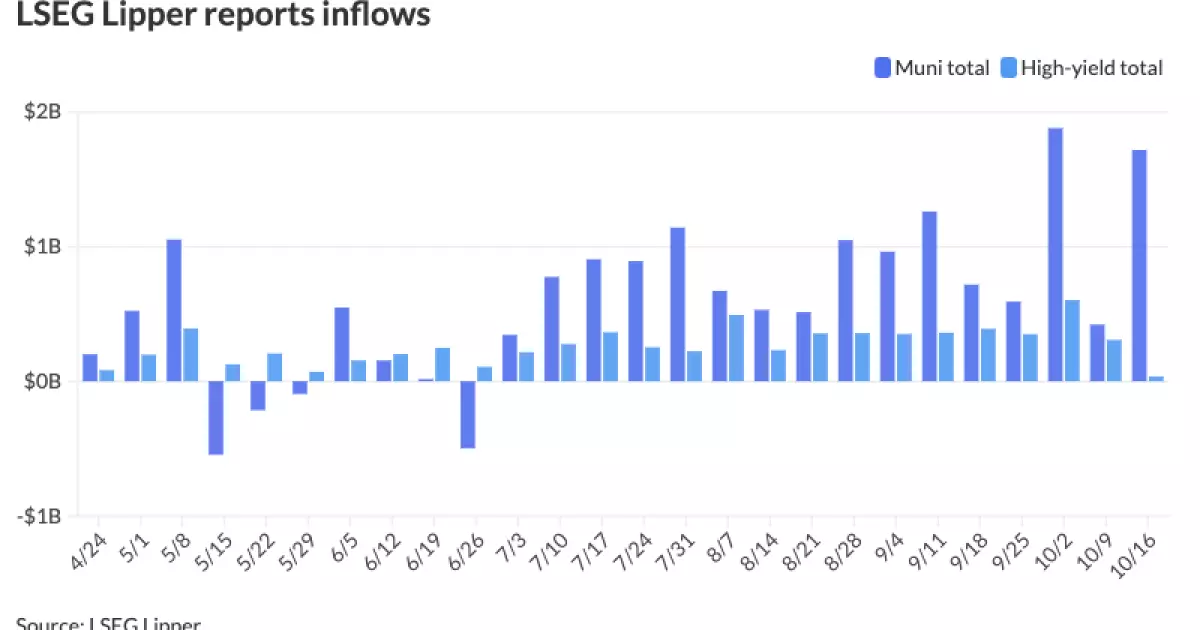The municipal bond market has displayed a relatively stable footing recently, with a noteworthy balance between supply and demand, indicating growing investor confidence. The latest data reveals that municipal mutual funds have experienced robust inflows, reflecting an appetite among investors for these tax-exempt securities. Notably, significant transactions like the New Jersey Transportation Trust Fund Authority’s issuance of $3.2 billion in transportation bonds have characterized a bustling primary market, aligning with broader trends in investment patterns across the fixed-income landscape.
In contrast, U.S. Treasury securities observed a decline in value, particularly for longer durations, while equities managed to gain ground. As of Thursday, the ratios of municipal yields compared to U.S. Treasuries indicated a steady state, with two-year and three-year maturities positioned at 62% and longer maturities reflecting similar relationships. This data crucially shapes the investment decisions and strategic planning for stakeholders within the municipal bond arena.
In the context of inflows, LSEG Lipper’s report signaled a significant increase in investment in municipal bond mutual funds, which added $1.718 billion for the week leading to Wednesday. This influx stands in stark contrast to the $420.7 million recorded in the previous week and marks the 16th consecutive week of positive inflow trends. High-yield municipal funds, although still reflecting inflows, saw a notable decline, highlighting a shift in investor preferences and risk appetite as they navigate the current economic climate.
According to J.P. Morgan strategists, these positive fund flows align with historical trends accompanying Federal Reserve easing cycles since 1992. Analyst Brad Libby of Hartford Funds noted that this correlation typically signals a decline in interest rates, positively influencing returns and subsequently driving investor flows into the municipal sector. The recent surge demonstrates that market conditions are favoring these assets, making them appealing to individual and institutional investors alike.
The primary market’s vibrancy has not gone unnoticed, with several substantial offerings hitting the market over recent days. Pennsylvania’s $1.6 billion general obligation bond sale, alongside the major transportation bonds issued by New Jersey, underscores a renewed enthusiasm among issuers looking to capitalize on favorable market conditions. Chicago’s O’Hare International Airport also entered the fray with its own significant offering, demonstrating healthy demand and strategic foresight in leveraging existing infrastructure needs to meet liquidity goals.
Kim Olsan from NewSquare Capital pointed to a promising supply forecast, with upcoming issuances projected to reach approximately $20 billion, slightly outpacing the combined offset through calls and maturities—to the tune of $2 billion lower. This scenario creates a net demand surplus, reinforcing the current trend of oversubscription seen across several A-rated credits in the market.
However, high-grade deals rated AA and above are currently facing slight concessions to ensure successful completions, indicating a complex interplay between buyer expectations and market pricing dynamics. The consensus suggests that while the demand remains robust, investors are becoming increasingly discerning about yield spreads and the associated risks.
As municipal bonds attract inflows and a diverse array of new issues emerges, it is essential to consider the broader implications for risk management and investment strategy. The reliability of municipal bonds, characterized by their tax-exempt status, positions them as an attractive option, particularly for those in higher tax brackets seeking to optimize their portfolios.
With impending interest rate adjustments and evolving economic indicators on the horizon, investors must remain astute, leveraging quantitative assessments to guide their decisions. A closer examination of yield curves can provide insights into the appropriate timing for entry and exit points within the municipal bond market.
As liquidity conditions evolve, the potential for public and private partnerships to enhance infrastructure funding will further support the momentum in the municipal bond sector. Such dynamics underscore the importance of understanding market movements and adopting a strategic approach rooted in comprehensive analytic frameworks.
The current landscape of the municipal bond market offers a compelling case for investment, bolstered by ongoing inflows, foundational market stability, and strategic issuance trends. As the municipal sector continues to adapt to changing economic conditions, stakeholders must remain vigilant in monitoring these developments, ensuring their positions align with the prevailing risks and opportunities. Overall, the future looks promising, provided that investors tread thoughtfully in a continually evolving financial landscape.


Leave a Reply